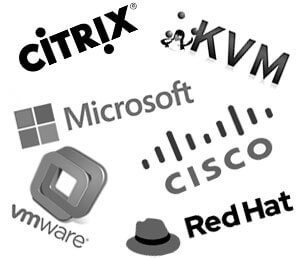Virtualization
In this article, first we declare some examples of virtualization advantages, so that you recognize this technology and the reason for its growing development, and then we will explain the inclusive and abstract definition the topics in this field.
Virtualization is an inevitable path ahead of companies Because not only will you not lose any opportunity and advantage, but you will also benefit from the following items
Significant economic frugality in the short and long term
Energy Conservation
Increased management and supervision
Improving the speed and quality of software services
Increase work efficiency
Data backup facility
Easier and more efficient conservation of services
Optimal use of available hardware capacity
Reduce the hardware needs
Better provision of information security
Information security management
The possibility of variation, much faster and with minimum energy consumption
Reducing the physical room used for IT systems in data centers and even users’ desks
Continuous chore and stability even in case of hardware failure or upgrade
Significant reduction in network bandwidth consumption
Increasing network and infrastructure stability
less noise and thermal pollution
And etc.
What is virtualization?
First, we intend to introduce the concept of virtualization in this article. And thereafter, we explain its types, applications and benefits of using this technology.
As you know, new generation computers consist of the following four layers:
operating system
hardware
Data
Software
generally, these 4 layers are interdependent, meaning that if there is a problem in the hardware, the operating system is having that problem too. For example: When the computer hard drive burns, the data and the operating system will be lost. Or when the power of the computer burns out, the system will not work.
and so forth, we try to solve these problems. In this way, we eliminate the problem of dependency between layers.
In other words, virtualization bonds hardware and operating system. And it allows you to implement several applications and operating systems on a physical system In a way that causes productivity in hardware and software costs, as well as optimal use of all system resources, cost reduction and energy consumption.
It was started in 1960 by IBM-INTERNATIONAL BUSINESS MACHINES. And it was presented as a logical way to divide system resources between different programs by mainframes.
Since then, the term virtualization has been expanded.
With this technology, we can simultaneously launch two or more operating systems on a single server.
This software technology provides a transformation in the vision of information technology (IT) as well as fundamental changes in the infrastructure of the organization.
It should be noted that many companies work in this area. And by providing virtualization solutions, various applications and etc., they lead the competition in this market. The most famous of them are mentioned below:

Types of virtualizations
Desktop virtualization is a software technology that separates the desktop environment and associated application software from the physical device to access it.
This can be used along with application and user profile management systems which is now called “user virtualization”. To provide a comprehensive desktop management system.
In this case, all desktop components are virtualized, which allows for a much more flexibility and secure desktop delivery model.
In computer science, storage virtualization uses better capabilities and advanced features in computer data storage systems.
In general, “storage system” is also known as a storage array or disk array or filtering.
Usually, storage systems use specific hardware and software along with disk drives. to provide very fast and reliable storage for data processing.
Storage systems are complex and may be designed as a specific computer to create a storage capacity with advanced data protection features.
A disk drive is only one element in a storage system, as well as the hardware and software embedded within the system.
Server Virtualization is concealing server resources, including the number and identity of individual physical servers, processors, and operating systems from server users.
A server administrator uses a software program to divide a server into virtual environments.
Virtual environment is sometimes referred to as virtual private server, but they are also referred to as guest, sample, container, or simulation.
Network virtualization is a classified external virtualization, combining many networks or network segments into a single virtual unit, or internal virtualization, providing network functionality like software components on a single network server.
In software testing, software developers use network virtualization for software testing that simulates the network environments in which the software is intended to be used.
Application virtualization is a software technology that isolates computer programs from the fundamental operating system that runs them.
A fully virtualized application is not installed in the traditional sense, although it runs the same way.
data center is a place where a large number of physical servers, physical routers and switches, monitoring equipment and mechanisms, physical network infrastructure, data storage equipment or physical storage, etc. are at your disposal.
Now, when it comes to Data Center Virtualization, it means that you have a large number of intangible virtual servers, virtual switches and routers, virtualized network infrastructures, virtual storage equipment or virtual storage, virtual traffic, virtual traffic management, virtual monitoring and… of which are done by a parcel called data center virtualization, for example, VMware VSphere software is one of these data center packages
How does virtualization works?
Some people mistakenly think that virtualization is only for data centers or large data centers.
but this perception is completely wrong. The leading companies in this field have designed this technology to be used for a wide range of networks.
From small networks with one server to large data centers with dozens or hundreds of servers and service provider. As mentioned earlier, virtualization advantages fulfills a wide range of organizations and individuals needs for a better use of resources, frugality and stability of services.
Virtualization benefits
This solution provides a strong and efficient way to get rid of the problems that come in the way every day.
Even if you just transfer a simple file server to virtualized technology, you will quickly discover its benefits. And sooner or later you want to virtualize your entire data center.
Below are some examples of the advantages of virtualization. By reading this, you will find that many problems will be solved in your company and organization by using this technology.



